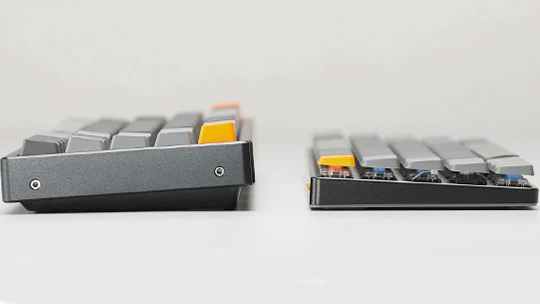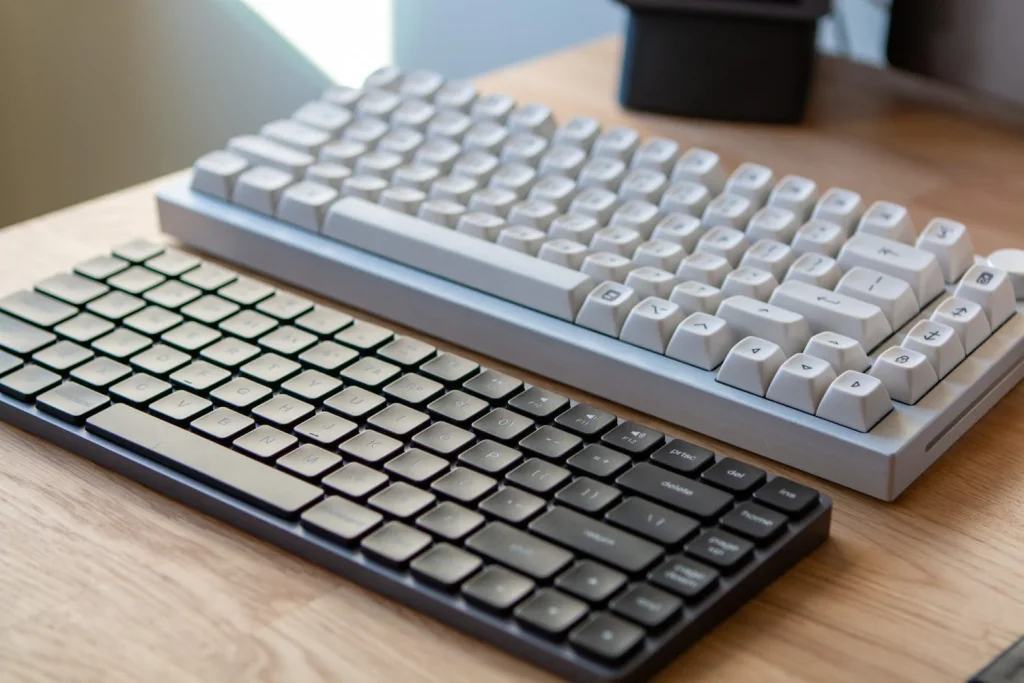In today’s hybrid world, a good keyboard is not just an instrument—it’s an enhancer of work and performance. You’re typing up documents or battling enemies in the latest FPS, and your keyboard selection will influence your experience fairly significantly. Two of the most divisive options are mechanical and low-profile keyboards.
Both are special in their own right and attract a different type of user. This guide examines the key differences, the pros, and the cons up close and helps you make the choice that is perfect for your needs in 2025—whether it’s work, play, or both.
What Are Mechanical Keyboards
Individual mechanical switches are used under every keycap of mechanical keyboards which vary in feel, sound, and actuation force based on the switch type (e.g., Cherry MX Blue, Red, Brown, or custom ones like Razer or Gateron).
Key Features:
Clear tactile or clicky feedback
Increased key travel distance (~4mm)
High durability (up to 100 million keystrokes)
Swappable switches and keycaps
Loved by typists and gamers alike
What Are Low-Profile Keyboards?
Low-profile keyboards are thinner with less travel (usually 1.5–2.5mm). They are designed to mimic laptop-type typing but more accurate than membrane keys.
Key Features:
Thin, sleek design
Faster actuation with less finger movement
Less wrist strain with shallower typing angle
Quieter keystrokes
Ideal for portability and sleek designs
Typing Experience: Comfort vs SpeedMechanical Keyboards:
Offer a more satisfying tactile response, especially with tactile or click switches.
Ideal for typists of long documents, emails, or code on a daily basis.
Need more finger travel and force, which can be tiring for some during extended sessions.
Low-Profile Keyboards:
Bring a light, quicker typing sensation, which is suitable for high-speed typists and occasional users.
Shorter travel distance implies less wear and tear over time.
Recommended by those coming from laptops because of familiarity.
Verdict: For comfort and ergonomics, low-profile takes the crown. But for precision and feel, mechanical keyboards are the way to go.
Gaming Performance: Speed vs TactilityMechanical Keyboards:
Provide switchable switches customized for various gaming requirements (e.g., linear for FPS games, tactile for RPG games).
N-key rollover and quicker response times are the norm.
Mechanical switches deliver more precise inputs, which is important in competitive gaming.
Low-Profile Keyboards:
Others with low profile (e.g., Logitech GL or Razer Low-Profile Optical) combine speed with a reduced profile.
Higher speed and less latency using less travel.
Ideal for high-speed games but may not offer the tactile feedback that some players appreciate.
Verdict: Mechanical keyboards remain the first choice for serious gamers, especially for gamers who need to depend on tactile feedback. That being said, low-profile keyboards are closing the gap where response and accuracy are concerned.
Noise Level: Clicky vs SilentMechanical:
Switch type determines sound (Blue switches are loud and clicky; Red or Silent switches are less noisy).
Is not ideal for quiet work environments unless dampening or silent switches are utilized.
Low-Profile:
Low-profile keyboards tend to be quieter than mechanical keyboards, making them more suitable for shared spaces and offices.
Optical low-profile keyboards are nearly silent without compromising on speed.
Verdict: If you are working in shared spaces or use a quiet space, low-profile keyboards are the solution.
Ergonomics & PortabilityMechanical:
Generally bulkier and heavier because of their taller profiles and deeper switches.
Require wrist rests for extended typing periods to prevent strain.
Low-Profile:
Lightweight and thin, thus extremely portable.
Better natural wrist angle without a wrist rest.
Ideal for minimal setups or use on-the-go.
Verdict: Low-profile keyboards for ergonomics and portability.
Customization & DurabilityMechanical Keyboards:
Highly customizable (keycaps, switches, lighting, macros).
Extremely durable—perfect for long-term investment.
Low-Profile Keyboards:
Little customization depending on the model.
Generally less durable but keeping pace with top-end low-profile mechanical counterparts.
Verdict: If you enjoy modding and tweaking, mechanical keyboards are the hands-down winner.
Conclusion: Which Should You Choose?
Use Case\tBest Choice
Typing-intensive tasks (e.g., writers, coders)\tMechanical Keyboard
Portable & ergonomic working environment\tLow-Profile Keyboard
Competitive gaming\tMechanical Keyboard (Linear or Optical switches)
Silent office setup\tLow-Profile Keyboard
Aesthetic and minimalist setup\tLow-Profile Keyboard
DIY and custom setups\tMechanical Keyboard
Final Thoughts:
Choosing between mechanical and low-profile keyboard is your preference. For tactile feedback and performance, go mechanical. For quiet, ergonomic typing and travel distance, go low-profile.
Luckily enough, most brands these days have low-profile mechanical hybrids, where you can have the best of both worlds.



